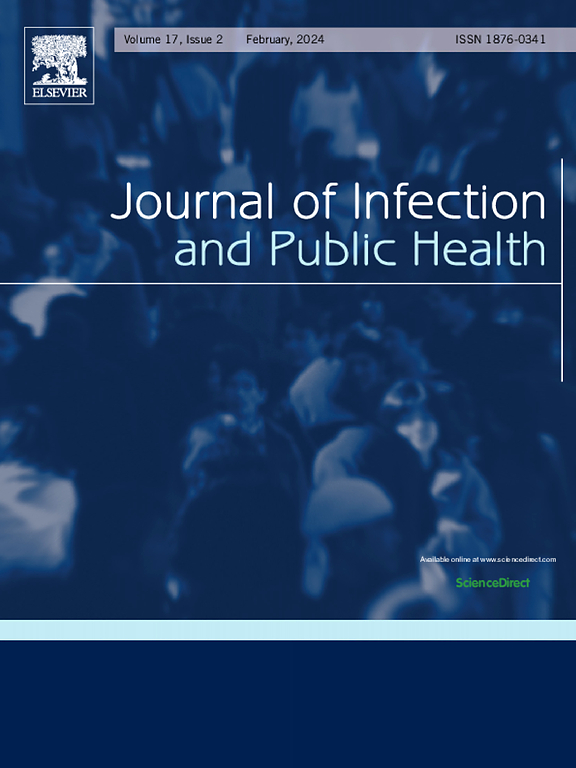New insights into the evolutionary origin of Francisella tularensis subsp. holarctica
IF 4
3区 医学
Q1 INFECTIOUS DISEASES
引用次数: 0
Abstract
Background
As a global expansion of Francisella tularensis subsp. holarctica in the northern hemisphere, its origin has been of great interest. Based on the phylogenetic analysis of the whole genome sequences (WGS) available in public databases, estimating temporal signal in accordance with random permutations of sampling dates, and searching the powerful SNPs within the B.16 clade, we intend to explore the historical origin of this subspecies and routes of dispersal across its regional distribution.
Methods
We constructed a phylogenetic tree for the four main clades based on 395 WGSs, including six B.16 strains. SNP analysis was performed to identify genetic signatures, while BactDating was employed to estimate the temporal divergence of the most recent common ancestor (MRCA). Data from comparisons of the six WGSs belonging to B.16 were used to screen putative SNPs, and generate new subclades for assigning B.16 strains from China. CanSNPer was used to assign the established canSNP nomenclature.
Results
A time-calibrated phylogeny estimated the MRCA of the four major clades at 2276 BCE (95 % CI: 3145–1446 BCE), with B.16 diverging approximately 1002 years earlier than B.4, B.12, and B.6. Within B.16, we identified one novel canonical single-nucleotide polymorphism, which assign Chinese strains (410108, 410109, and 410111) to the terminal clade named B.316. We depicted the distribution of B.4, B.6, B.12, and B.16 in 32 countries across five continents, including detailed distributions in subordinate regions of Russia/USSR, and the distribution of B.4, B.11, B.16, and B.20 related to China in other countries worldwide.
Conclusions
Given that Asia, specifically China, harbors the distribution of four major genetic clades including the earliest diverging B.16, we hypothesize that subsp. holarctica likely have originated in Asia/China and subsequently spread worldwide. These findings enhance our understanding of the pathogen’s evolutionary history and provide a framework for refining disease surveillance strategies.
土拉菌亚种进化起源的新认识。holarctica
背景土拉菌是一种全球扩张的菌株。全北极位于北半球,它的起源一直引起人们极大的兴趣。基于公共数据库全基因组序列(WGS)的系统发育分析,根据采样日期的随机排列估计时间信号,并在B.16分支中搜索强大的snp,我们将探索该亚种的历史起源及其在区域分布中的传播途径。方法基于395份WGSs,包括6株B.16菌株,构建4个主要分支的系统发育树。SNP分析用于识别遗传特征,BactDating用于估计最近共同祖先(MRCA)的时间差异。从属于B.16的6个WGSs的比较数据中筛选推测的snp,并生成新的亚支用于定位来自中国的B.16菌株。使用CanSNPer来分配已建立的canSNP命名法。结果经时间校准的系统发育分析估计,4个主要支系的MRCA在2276 BCE(95 % CI: 3145-1446 BCE),其中B.16比B.4、B.12和B.6早1002年。在B.16中,我们发现了一个新的典型单核苷酸多态性,将中国菌株(410108、410109和410111)定位为末端进化支B.316。我们描述了B.4、B.6、B.12和B.16在五大洲32个国家的分布,包括俄罗斯/苏联下属地区的详细分布,以及与中国有关的B.4、B.11、B.16和B.20在世界其他国家的分布。鉴于亚洲,特别是中国,拥有四个主要的遗传进化支的分布,包括最早的b16分支,我们假设亚种。全北极可能起源于亚洲/中国,随后传播到世界各地。这些发现增强了我们对病原体进化史的理解,并为改进疾病监测策略提供了框架。
本文章由计算机程序翻译,如有差异,请以英文原文为准。
求助全文
约1分钟内获得全文
求助全文
来源期刊

Journal of Infection and Public Health
PUBLIC, ENVIRONMENTAL & OCCUPATIONAL HEALTH -INFECTIOUS DISEASES
CiteScore
13.10
自引率
1.50%
发文量
203
审稿时长
96 days
期刊介绍:
The Journal of Infection and Public Health, first official journal of the Saudi Arabian Ministry of National Guard Health Affairs, King Saud Bin Abdulaziz University for Health Sciences and the Saudi Association for Public Health, aims to be the foremost scientific, peer-reviewed journal encompassing infection prevention and control, microbiology, infectious diseases, public health and the application of healthcare epidemiology to the evaluation of health outcomes. The point of view of the journal is that infection and public health are closely intertwined and that advances in one area will have positive consequences on the other.
The journal will be useful to all health professionals who are partners in the management of patients with communicable diseases, keeping them up to date. The journal is proud to have an international and diverse editorial board that will assist and facilitate the publication of articles that reflect a global view on infection control and public health, as well as emphasizing our focus on supporting the needs of public health practitioners.
It is our aim to improve healthcare by reducing risk of infection and related adverse outcomes by critical review, selection, and dissemination of new and relevant information in the field of infection control, public health and infectious diseases in all healthcare settings and the community.
 求助内容:
求助内容: 应助结果提醒方式:
应助结果提醒方式:


